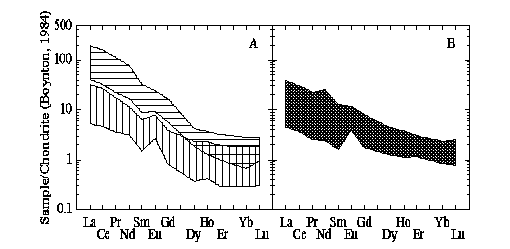
Quite common deep-seated xenoliths in kimberlites are bi-mineralic eclogites, while kyanite-bearing eclogites
are rare. In this study we analyzed a suite of 18 aluminous eclogites from the Zagadochnaya Pipe, Yakutia, Siberia. This is the type locality for grospydites. Grospydites (grossular, pyroxene, and kyanite (disthen) bearing eclogites) are represented by a grossular component in garnet at least with 50 mol%. Most of the samples analyzed here are grospydites according to this definition.
Investigations of deep-seated eclogites from various areas in the world show chemical contamination by the kimberlitic host melt. In contrast to the highly alterated kyanite-bearing eclogites from Roberts Victor, South Africa all of the 18 kyanite-bearing eclogites from Zagadochnaya are fresh or only slightly alterated. Observations on thin-sections show no notable interaction between grospydite xenoliths and kimberlitic melt. In such areas where kimberlitic melt is in contact with the xenolith outer rim minerals, there is a sharp border between both types of material. Examining major and trace element distribution we show that there was no significant chemical interaction between kimberlitic melt and grospyditic eclogites.
The distribution of the elements Ni, Cr, and Mg reveals no significant mixing of the grospyditic eclogites and kimberlitic host melt. The Ni component in ky-eclogites varies from 58 to 201 ppm whereas the variation among
710-1600 ppm in kimberlites is known (Dawson, 1980). Therefore, all bulk xenoliths analysis of this study are whole rock data.
Some nodules show small micaceous kimberlitic parts at their edges. The REE patterns for the analyzed ky-eclogites, and lower crustal anorthosites from the Bohemian Massif (Austria) are given in Figure 1. The Eu/Eu* ratio in slightly alterated ky-eclogites (group of higher enriched REE) varies from 1.1 to 1.6, whereas fresh ky-eclogites have ratios among 1.6 and 2.4. Those fresh grospydites plot close to the pattern of lower crustal anorthosites. We propose an origin of Siberian grospydites as high grade equivalents of former anorthosites.
Dawson, J.B., Kimberlites and Their Xenoliths, Springer, 252 (1980).
Fig. 1: The REE pattern of Siberian grospyditic eclogites are represented in A. Fresh eclogites are signed by vertical hachures whereas slightly alterated eclogites are plotted with horizontal hached signature. REE pattern of lower crustal anorthosites from the Bohemian Massif (Austria) are represented in B.